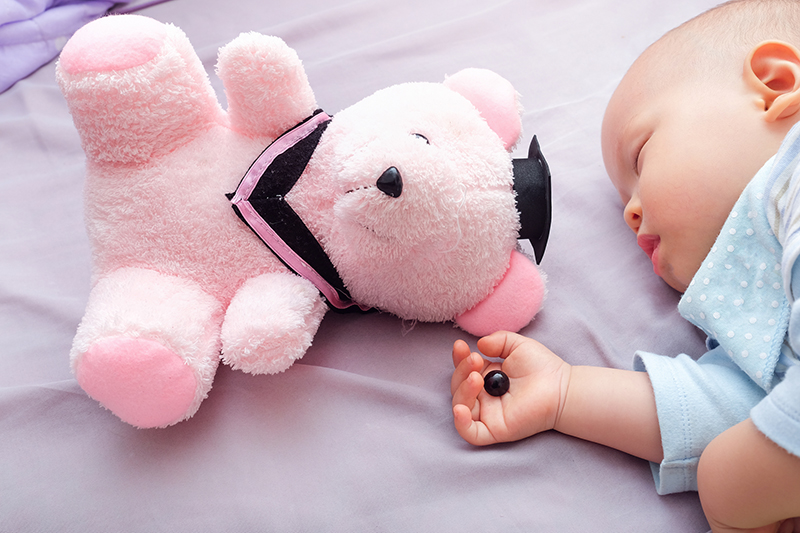Families For Life | Choking Prevention and Choking Risks-Babies

DID YOU KNOW?
Play is a great relationship builder. Spending time playing with your child sends a simple message – you are important to me. Help your child learn about who she is and where she fits in the world.
READ MORE

Choking risks for babies and toddlers include objects smaller than a D-size battery. Keep small objects out of reach until your child is less likely to choke. This is usually around three years of age.
Choking risks
Choking happens when a child’s airway gets blocked by something. Anything smaller than a 20-cent coin can cause an airway blockage and be a choking risk for children.
Here are examples of choking risks for babies and young children.
Food choking risks include:
nuts and seeds, including popcorn kernels
hot dogs and sausages
pieces and bones of meat, including chicken or fish
hard foods like crackers and corn chips
lollies and marshmallows
unpeeled food like apples, nectarines, grapes and tomatoes
fruit pips and stones
raw vegetables like carrots, uncooked peas and lettuce leaves
stringy food like celery and pineapple.
Household choking risks include:
coins
small or button batteries
small magnets
the tops of pens and markers
jewellery.
Toy and toy part choking risks include:
plastic shapes
marbles
the eyes of stuffed toys
table tennis balls
uninflated or popped balloons.
Other risks include small things like tablets and chewable vitamins, chewing gum, stickers (like those on fruit) and garden objects (like pebbles).
Do you know what to do for a choking child? Our choking first aid article can take you through the steps.
Preventing choking while your child is eating: tips
These tips can help you protect your child from choking:
Where your child eats
Supervise your child. This means you can respond quickly if your child chokes.
Ensure your child is sitting down. Your child is more likely to choke if they eat while lying down, running around or playing, so sitting at a table or even on the floor will reduce the risk.
Sit with your child while they eat, and talk to or entertain them. This way they’ll be less tempted to get up and run around.
Avoid giving your baby a bottle in bed. Babies who fall asleep with a bottle can draw liquid into their lungs and choke.
What your child eats
Until your child can chew well, give your child food in pea-sized pieces or smaller. Anything bigger than this is hard for young children to eat safely.
Don’t give your child whole nuts and seeds or similar hard foods until they’re 4 years old.
Remove bones from meat and fish. Remove pips from foods like olives and cherries.
Cook, grate or mash hard foods, particularly hard fruit and vegetables like carrots and apples.
Peel the skin off fruit like apples, nectarines and grapes.
How your child eats
Don’t give your child food while they’re crying. Your child won’t be able to chew and swallow their food properly if they’re crying.
Encourage your child to chew food well. If your child chews and swallows properly and takes their time during meals, this will reduce their risk of choking.
Preventing choking around your home: tips
These tips can help you protect your child from choking around your home:
Try to keep small objects out of reach. Curiosity leads children to put unusual things into their mouths. Check the floor for small objects by getting down to child height and looking around.
Always follow the age recommendations on toys. Use toys that are solid and sturdy, and avoid toys with small parts, breakable parts or brittle surfaces. Check toys for exposed stuffing and loose screws and buttons.
Avoid buying toys with button batteries. Check the battery compartments on items in your home to make sure they’re secured with a screw. Keep loose button batteries or objects with unsecured button batteries out of reach and in child-resistant containers.
Keep toys for small children and older siblings in separate boxes. Encourage older siblings to keep their little toys out of reach. This might include Lego, doll clothes, beads, car parts and so on.
Children at higher risk of choking
Children under 4 years old are at higher risk of choking, but older children can also choke.
Children with disability or chronic illness might also be at higher risk of choking than other children.
Children are more likely to choke if they have conditions like cerebral palsy, epilepsy, intellectual disability or gastro-oesophageal reflux disease. If your child has one of these conditions, talk to your doctor about how best to avoid choking.
© raisingchildren.net.au, translated and adapted with permission
Explore more